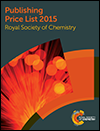You know you can trust Royal Society of Chemistry journals to deliver high quality content.
Our exceptional standards are reinforced by the recently published 2013 Journal Citation Reports ®:
Individual journal Impact Factor (IF) highlights include: Chemical Society Reviews (up 22% to 30.425); Catalysis Science & Technology (up 27% to 4.760) and Energy & Environmental Science (up 33% to 15.490).
Energy & Environmental Science remains the top journal in the Environmental Sciences category, and is now in the top 5% in the other three categories where it is listed.
Natural Product Reports is #1 in the Chemistry: Medicinal category with a figure of 10.715.
Chemical Science, recently announced as moving to Gold Open Access in 2015, records an improved figure of 8.601. This is one example of how we, as a not-for-profit organisation, support and invest in the community.
Looking at all our journals in the multidisciplinary chemistry category:
- Of the top 20 journals in this category, six are from the Royal Society of Chemistry. No other publisher has more.
- It’s the same when you look at 5-year Impact Factors: no other publisher has more in the top 20
- 33% of our journals have an IF above 5
- 83% of our journals now have an IF above 3
- Three-quarters (76%) of our journals are in the top 25% of their ISI categories
More authors are choosing to publish their best work with us, and we have achieved all this while publishing more than double the number of articles in 2013 compared with 2010.
So the figures speak for themselves: our journals are the best place to publish work that advances excellence in the chemical sciences. For guaranteed impact, choose Royal Society of Chemistry journals.
You could contribute to our next Impact Factor… Register to receive email updates about our journals including calls for papers, most accessed articles, themed issues and breaking news.
![]()
| Journal | 2013 Impact Factor | 5-Year Impact Factor |
| Analyst | 3.906 | 4.097 |
| Analytical Methods | 1.938 | 1.913 |
| Catalysis Science & Technology | 4.76 | 4.764 |
| Chemical Communications (ChemComm) | 6.718 | 6.485 |
| Chemical Science | 8.601 | 8.547 |
| Chemical Society Reviews | 30.425 | 33.159 |
| Chemistry Education Research and Practice* | 1.309 | 1.436 |
| CrystEngComm | 3.858 | 3.908 |
| Dalton Transactions | 4.097 | 3.959 |
| Energy & Environmental Science | 15.49 | 15.263 |
| Faraday Discussions | 4.194 | 4.193 |
| Food & Function | 2.907 | 3.132 |
| Green Chemistry | 6.852 | 7.081 |
| Integrative Biology | 3.996 | 4.455 |
| JAAS (Journal of Analytical Atomic Spectrometry) | 3.396 | 3.134 |
| Journal of Environmental Monitoring | 2.109 | 2.133 |
| Journal of Materials Chemistry | 6.626 | 6.743 |
| Lab on a Chip | 5.748 | 6.002 |
| MedChemComm | 2.626 | 2.737 |
| Metallomics | 3.978 | 4.010 |
| Molecular BioSystems | 3.183 | 3.359 |
| Nanoscale | 6.739 | 6.925 |
| Natural Product Reports (NPR) | 10.715 | 10.353 |
| New Journal of Chemistry (NJC) | 3.159 | 2.837 |
| Organic & Biomolecular Chemistry (OBC) | 3.487 | 3.389 |
| Photochemical & Photobiological Sciences | 2.939 | 2.793 |
| Physical Chemistry Chemical Physics (PCCP) | 4.198 | 4.023 |
| Polymer Chemistry | 5.368 | 5.676 |
| RSC Advances | 3.708 | 3.708 |
| Soft Matter | 4.151 | 4.429 |
| Toxicology Researchǂ | 3.273 | 3.273 |
ǂ Partial IF only
*Chemistry Education Research and Practice is listed in the Education, Scientific Disciplines category. It is the highest ranked journal devoted solely to chemistry education.
The Impact Factor provides an indication of the average number of citations per paper. Produced annually, Impact Factors are calculated by dividing the number of citations in a year, by the number of citeable articles published in the preceding two years.
The 5-Year Impact Factor is the average number of times articles from a journal published in the past five years have been cited in the Journal Citation Reports year. For journals in subjects where citation activity continues to rise through several years, this metric allows more of their total citation activity to be included in a critical performance metric.
Data based on 2013 Journal Citation Reports ®, (Thomson Reuters, July 2014).












